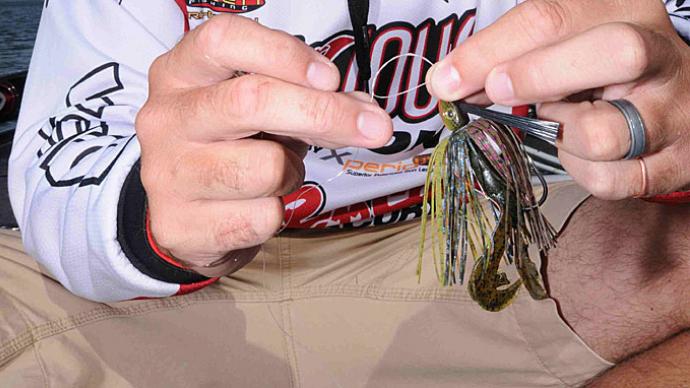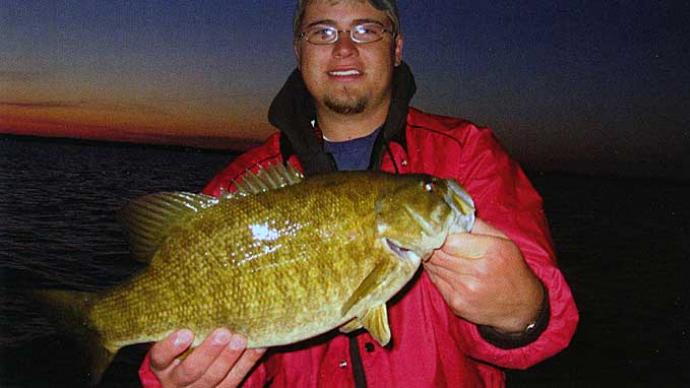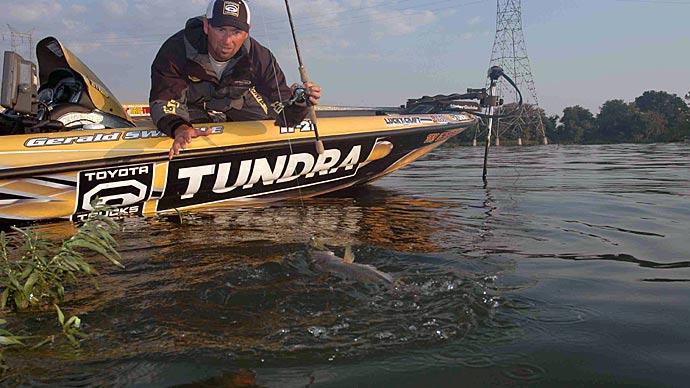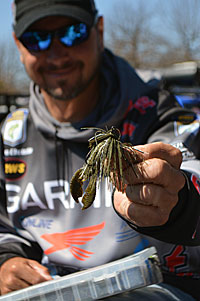
When most bass anglers dream of the ideal place to fish, they envision a quiet stretch of shallow water filled with heavy cover such as aquatic vegetation, brush, and laydowns. That perfect scenario hasn’t changed much over the years. Neither have the lures they’d use to attack it — with some notable additions. One of those is a swim jig.
Built like the standard bottom-bouncing version — lead head, hook, skirt, and trailer — swim jigs are fished around cover and high in the water column. “It’s a subtle spinnerbait,” said Bassmaster Elite Series angler Jason Christie, who used one to win the 2014 Elite Series stop at Arkansas’ Lake Dardanelle with 72 pounds and 3 ounces. He said swim jigs are perfect in clear water, where a natural-looking lure that moves fast will generate reaction strikes from bass that can’t get a good look at it. “That is where a swim jig shines,” he said. And they aren’t dull in dirty water, either.
Fellow Bassmaster Elite Series angler Steve Kennedy also is familiar with the power of swim jigs, especially when it comes to catching big bass. “Every lake we fish has a year class [of bass] that we all are fishing for,” he said. “So, one bigger fish will separate you [from the field]. Two or three, and you’re in the top 10.” He used a swim jig to catch more than a couple of those in 2017 when he won the Elite Series tournament on Dardanelle with 63 pounds and 12 ounces.
Christie’s biggest bass on a swim jig was a largemouth that weighed about 8 pounds. But he doesn’t see swim jigs as a one-species wonder. He uses them to catch plenty of smallmouth, too. “A lot of those smallies up North hang with and act like largies,” he said.
Kennedy finds the best swim jig bite during post-spawn when the water is between 68 and 75 degrees, the shad spawn is on, and bass are ready to chase. But that’s not the only time he picks one up. It works anytime and anyplace where bass are holed up in heavy cover. He’ll even reach for one when the water is cold. He’s seen it produce when the water temperature is in the 40s, as long as it coincides with a strong warming trend inviting bass to shallow water.
With so many benefits, it’s easy to see why Christie and Kennedy frequently fish swim jigs. Through that amount of use, each has developed a perfect setup for fishing them, making them even more productive. Knowing and applying those details will improve your swim jig fishing. So, here are their perfect outfits — rod, reel, line, and lure — for fishing swim jigs.
Rod
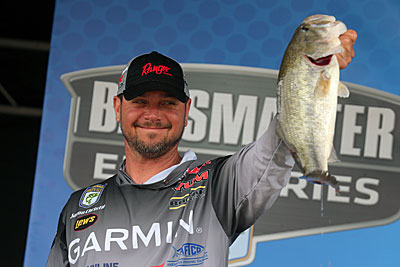
Water clarity determines which of two ways Christie fishes a swim jig. He'll make long casts when the water is clear, swimming it back a couple of feet deep. The bass must see it to eat it, so he moves it fast. As water clarity diminishes, he shortens his casts to pitches, making it easier to keep his swim jig moving slowly while remaining high in the water column. He said a swim jig would catch bass in really dirty water, but you need to fish it in shallow water, where bass have a better chance of feeling its presence.
Each of Christie’s swim-jig presentations demand a specific rod. When casting a swim jig, he uses a 7-foot 3-inch Falcon rod. “I keep the rod at about 11 o’clock, keeping [the swim jig] high in the [water] column,” he said. “Most of the bites you’ll get aren’t visible bites. I want [a rod] with a little bit of [a slower-action] tip to let the fish get my jig in its mouth.” That delay as the rod loads up gives bass time to inhale the jig and turn sideways before the hook moves on the set.
Christie’s second swim jig rod is Falcon’s Cara pitching and swimbait rod, which measures 7 feet and 3 inches. The rod sports a faster tip than his casting rod. “A lot of these bites I can see, so I can give them a half-second [to inhale the swim jig before setting the hook],” he said.
Kennedy keeps things simple, employing one rod for his swim jig fishing. “My favorite setup is a 7-and-a-half-foot extra-heavy rod,” he said. It matches his swim-jig approach: heavy gear for heavy-weight bass in heavy cover.
Reel
Christie matches his reels to his rods. He uses an 8.3:1 Lew’s Super Duty baitcasting reel on his pitching rod. He slows down a bit when casting a swim jig, choosing one with a 7.5:1 gear ratio. Some of the differences can be attributed to line management. The time he saves retrieving his jig at the end of a pitch can be applied to making more pitches, and thus more chances for bites, during a day.
At first glance, it looks like Kennedy chooses a slower reel than either of Christie’s choices. But numbers don’t tell the whole story. Kennedy’s Shimano reels feature a 6:1 gear ratio and spools larger in diameter than most others. The latter means more line is retrieved on each revolution, matching the retrieve speed of reels with faster gear ratios but smaller spools.
Line
Christie matches his line — pound test and material — to the presentation. When casting a swim jig, he uses braided line, either 30- or 50-pound test SunlineSunline, when casting a swim jig. It has nearly no stretch, providing sensitivity and solid hooksets, even at the end of a long cast. And he goes without a fluorocarbon or monofilament leader, feeling bass don’t watch line as much as many anglers believe.
Christie uses 25-pound test Sunline fluorocarbon line on his pitching rod. “It’s one of those deals where I am going to see them bite, and I’m going to hit them as hard as I can, and I don’t want the line to break,” he said. “Everything has gotten so crisp — the rods, the braid with no stretch — something has to give.” The fluorocarbon line has slightly more stretch than braid, providing the cushion he wants. A slower-action rod provides that cushion when casting. “And when you get them that high [in the water column], they aren’t going to drag you down into the cover,” he said. So, there’s no need to turn to a more abrasion-resistant braided line.
Kennedy combines line materials, adding a few feet of 25-pound test fluorocarbon leader to a 65-pound test main line. Besides blending into the surroundings better, he feels the heavy fluorocarbon leader is needed to thwart breaking off bass on hooksets and better manage the heavier swim jigs he usually throws. “When you get those big bites, you can’t afford for anything to go wrong,” he said.
Jig and trailer
Many anglers gravitate toward lighter-weight swim jigs, believing they are easier to keep closer to the surface. Kennedy goes in the opposite direction. “I’m typically swimming a 5/8- or 3/4-ounce jig,” he said. “It’s more of a flipping style jig. It comes through [cover] well. The key to it is the drop. Most jigs don’t fall fast enough. They don’t get that reaction strike.”
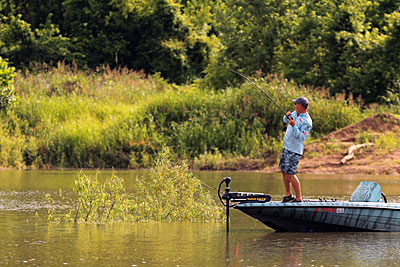
Kennedy can rattle off several tournaments when he finished well with a heavy jig, swimming it quickly between abrupt stops. “You’ll be swimming it high, fast, and hard, and when you kill it, all you see is a mouth,” he said. “It’s like dropping it in a bucket. I liken it to the Crazy Ivan maneuver from the movie ‘The Hunt for Red October.’ You get a bass tracking behind it, but he won’t hit it up high. And then when it dives, he has to eat it or give up his position underneath it.”
The vertical movements that Kennedy adds to his swim jig retrieves are part of today’s tournament fishing game. “Nothing we do is just throw and reel,” he said. “Finding the cadence that [the bass] want is part of the game. It’s not the same every day. It’s not even the same hour to hour.”
Christie also isn’t particular about the type of jig he swims, as long as it weighs at least ½ ounce. “As long as you get the weight right, I think it is all about the same,” he said. He prefers a heavier jig for several reasons. “I like to move it a little bit quicker, and you have more control,” he said. “I can make that jig go up and down — bounce — with a heavier weight.” Like Kennedy, he feels that pushes bass to strike. He adds rattles to help them find his swim jig in dirty water. He said every time the jig points down or up, the rattle clicks, giving bass an audible clue to its location.
Christie only uses three colors of swim jigs: green pumpkin, black and blue, and white. One of those will work in every situation, he said. He dresses each with a matching Yum Craw Chunk. He said it has a good swimming action — when one leg is up, the other is down. “At slow speeds, it’s kicking, and at high speeds, it doesn’t get overrun with water and blow out,” he said.
Kennedy adds a white Zoom Super Chunk trailer to his white swim jig. That trailer might not kick as much as others on the market, but that’s okay with him. He qualifies his choice in other ways. “The jig looks like a shad, and each tail [on the chunk] looks like a shad,” he said. “It looks like a small school [of shad]. That bigger profile helps attract bigger bass.”
BassResource may receive a portion of revenues if you make a purchase using a link above.


